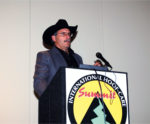Advertise Follow Us
Articles Tagged with ''long toes''
A pair of Texas farriers share how they deal with this all-too-common problem
Read More
Online with the Farriers' Forum
Dealing With A Laminitic, Low-Heeled, Long-Toed, Flat-Soled Horse
Read MorePad Choice
The Frog-Support Pad
Knowing how to use this pad is vital for therapeutic work and useful in day-to-day shoeing
Read More
Apply Two Basic Principles to the Long-Toe, Low-Heel Hoof
Trim away the bent horn tubules to get down to the straight ones, and deal with each foot on its own merits, says a noted farrier and teacher
Read More
Using the Roller Motion Shoe
Therapeutic shoe slope and raised heels are useful in dealing with a variety of hoof abnormalities
Read More
Shoeing To Minimize Knee Action In The Western Pleasure Horse
The less knee action, the better
Read More
Bilateral Toe Cracks
Radiographs and measuring from the center of rotation help overcome common foot conformation concerns
Read More











